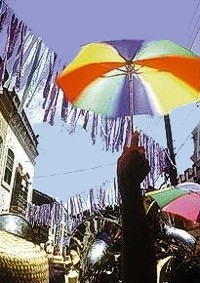|
|
Frevo in Recife
«Recife
«Entertainment in Recife and Pernambuco
«Culture of Pernambuco
«Carnival in Recife
«Carnival in Olinda
 Frevo, as a kind of music, has its origins in the repertoires of the military bands in the second half of the 19th century, in Recife. The maxixe (pronouced - masheshe), the Brazilian tango, the quadrille, the gallope, and more particularly, the military two-step and the polka, somehow became combined into a form of hybrid dance, the result of which was - frevo. It is a creation of the Recife carnival, which even today, is still going through a musical and choreographic evolution.
Frevo, as a kind of music, has its origins in the repertoires of the military bands in the second half of the 19th century, in Recife. The maxixe (pronouced - masheshe), the Brazilian tango, the quadrille, the gallope, and more particularly, the military two-step and the polka, somehow became combined into a form of hybrid dance, the result of which was - frevo. It is a creation of the Recife carnival, which even today, is still going through a musical and choreographic evolution.
Academically, it is generally agreed that the word frevo was created from the verb "ferver", meaning - to boil. It is worth noting, however, that the word is used with an inversion of the letters 'e' and 'r', which is a common error of pronunciation amongst the lower classes. The word, in fact, is to be found in this same context, in popular 18th century dramatic pieces. This fact is revealed to us by Francisco Pacífico do Amaral, through his descriptions of the celebrations in honor of the State Governor, José César de Menezes, on 19th March 1775, when the two 'hermits', Antão e Bernabé, sing : "Dizei bem, vá de função, / Ferva o meu Padre a folia / Bebamos, que a tudo chegam / As esmolas da caixinha".
As the music is always played by brass-bands in the clubs and the troças, it is essential to have a well equipped band. There are five C flat clarinets, two C flat alto saxophones, two C flat tenor saxophones, seven C flat trumpets, ten drums in A, two C flat tubas, one bombardon drum in A, two smaller drums, a tambourine, a reco-reco (a tube, often of undulated metal that is scraped with a small stick) and maracas. There is a total of 36 musicians, which can be reduced or increased, depending on the financial possibilities of the group.
The Street Frevo music begins with an introduction, generally of 16 beats, followed by a call, known as the "reply". The "reply" has the same number of beats, and precedes the second part, which is not always merely a reproduction of the introduction. According to the terminology of musicians and composers, Street Frevo is divided into a number of different types. There is the Drowning Frevo (or the Meeting Frevo) in which a series of long, loud notes are played by the band with the objective of drowning the sound of a nearby rival club orchestra. The Coco-nut Frevo is a variation of the previous, and is made up of short sharp notes in rapid succession. The Gale Frevo is contains a lively melody, where the woodwind instruments feature in the execution of the semibreves, producing a fairly moderate tone between high and low. The Ball-room Frevo is a form currently used by the new composers, and is a mixture of the previously mentioned three. As with the Gale Frevo, it is to be found exclusively in the clubs and ball-rooms, and the orchestra uses less brass, in favor of the woodwind instruments.
Although Street Frevo is always to be found in all the clubs and ballrooms during the days of carnival, it was in fact, originally created to be performed in the open-air. It is to be found in, what is known as, the troça1 groups, the 'pedestrian' clubs and the enormous crowds that follow them. As the name suggests - it is really Street Frevo. Its basic melody is responsible for the choreography of the step and for its practitioners, in Recife, Olinda and other cities throughout this immense country of carnival.
Read more about Frevo
(some samples available).
Source: The city of Recife.
| |